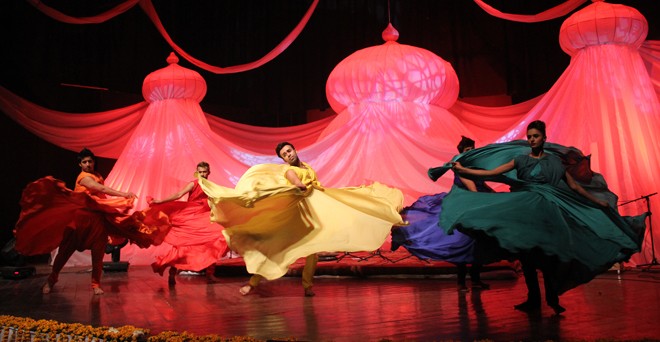

When the Rafi Peer Theatre Workshop decided to shift the 12th Sufi Soul Mystic Music Festival to the Alhamra on the Mall, as they did their Film Festival held a few weeks back, the decision was widely welcomed. Fears were also expressed that the venue does not guarantee the space and the freedom that the audiences had gotten used to at the Alhamra Cultural Complex and the Rafi Peer Cultural Centre on Raiwind Road.
It was welcomed because the venue on Raiwind Road, though ideal for a mela like atmosphere closer to the ethos of big festival or public event, was too far off. There had not been shortage of audiences even there but the concern that the ordinary man does not gratify his love for music and the other performing arts, finding it difficult to commute to the suburban area of Lahore in the absence of a proper public transport network operating in the city, was legitimate.
The fears were proved right because many more people turned up at the Mall than the halls had the seating capacity for. The last two days of the three day festival were very disappointing for a large number of people who had gone there to be part of the show but had to be turned back because of lack of physical space.
Alhamra Cultural Complex where most of the festivals were held in the past is an ideal venue but had to be shifted about five years back when the place was targeted by those who want this society to be bereft of music and theatre. The place is too big and sprawling. Though it can be made secure, it requires much more effort and resources than currently available with the Alhamra Complex or the administration.
The disappointing aspect of the festival was that many foreign artistes who were invited and had accepted the invitation to be part of the festival dropped out due to security concerns that they or their countries had.
Festivals like these have been held to showcase to the world that life has to go on despite grave and genuine concerns, now voiced openly all over the world. But the local artistes and the audiences proved once again that they do have the courage to allay the concerns and counter the fears that have gone in attendance of such events since the last ten years or so. The local people, it appears, have reconciled to the reality of their existence by dividing their lives into segments -- they have concern for the safety of their wives and children but they also want to live a normal life and share whatever the artistic pleasures this society has to offer.
It was a shame because this platform has hosted more foreign artistes than any other and it has also exposed the local audiences to a whole array of music in the Muslim world. It is rare or was rare that music groups visited Pakistan from Muslim countries and that too in such vast numbers representing a vast diversity. The few official delegations especially from the former Central Asian Republics flaunted their musical heritage but the others were focused on either literature, calligraphy or an occasional film festival. Artistes from Iran, Azerbaijan, Syria, Turkey, Indonesia and Iraq have performed in these festivals in their forms and with their instruments while the lyrics too have varied from country to country.
It was evident from the festivals, and now also through the internet and satellite channels, that the Muslim world is awash with musical expression. Right from Brunei in the east to Mauritania in the west there is so much music. Diversity and great vibrancy forms part of their culture and society like in any other part of the world.
Unfortunately, the position on ground or the living culture of the various Muslim societies has never been an area of our understanding; rather, it is always narrowed down to the theologians’ interpretation of some normative existence. There is an absence of the historian, the cultural anthropologist, the art critic and the sociologist from the array of scholars meant to give a proper picture of life and realities of the people rather than to be fitted into the supposed straitjacket of some narrow discourse.
This has distorted our approach, and when we are in the presence of the arts, visual or performing, we feel guilty of yielding to temptation and somewhere at the back of our minds constantly fighting some prejudice or warding off a deep seated suspicion.
As in the past festivals, the artistes hailed from all the regions of the country, Gilgit Baltistan, to Balochistan to Cholistan and interior Sindh besides the quasi urbanised areas of the Punjab and Sindh.
These included Zarsanga, Akhtar Chinar Zehri, Sanam Marvi, Sain Zahoor, Krishan Lal Bheel, Shah Jo Raag Fakirs, Areeb Azhar, Wahab Shah, Nawab Khan, Bashir Lohar, Qawwals Mahboob Mian Meeri, Imran Aziz Mian, Shahzad Ahmed Santo, Ishfaq Ahmed Jaza Hussain, Faiz Ali Chishti bradaran, Sher Miandad, Badar Khan, Mehboob Faridi, dholias Goonga and Mithu Sain, Shaukat, Papu Sain, and vocalists from Gilgit Baltistan Bazm e Liqa.
Some of the performers rendered their musical forms in the understanding of what the urban audiences appreciate in places like Lahore. By interjecting lyrics of languages widely understood and some contemporary instrumentation, they were attempting to give a colourisation of modernity.
Living in their areas it is possible there is demand for greater modernisation. Then in the bigger media outlets that are controlled by urban freaks with their finger constantly on the button of television ratings, a greater standardisation of expression is required. But in niche festivals, it is expected of these performers to be as close to their pristine repertoire as possible.
These artistes now live within the pulls they face in different directions and this probably defines the ground they have to creatively engage in.